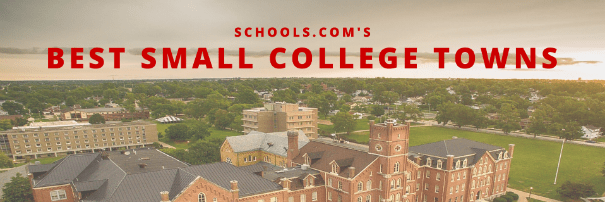
Living in a vibrant college town can have a positive impact on a student's educational experience, regardless of how they attend their classes. For schools with campus-based students, proximity to their college or university, even if they're taking some online courses, means greater access to fellow students and faculty who can help answer questions, assist with assignments or provide a sounding board for projects.
For online students, the local culture can help them combine their nontraditional educational experience with some of the perks of living near a college, such as a youthful population, varied entertainment options and a strong sense of community — not to mention potential access to a college library. In addition, these areas often have the advantage of a student-centered population and a cost of living that's more likely to fit within a student's budget.
Every college student may develop their own opinion on what makes the perfect small town experience, but for those who want to start by weighing the data, we've put together the following list. We scored 170 U.S. cities that have both a four-year college and a population of less than 150,000 on several criteria, evaluating both economic and quality of life factors. Read more about our methodology, or scroll on to check out our list of the best 25 small college towns.
1. Fargo, North Dakota
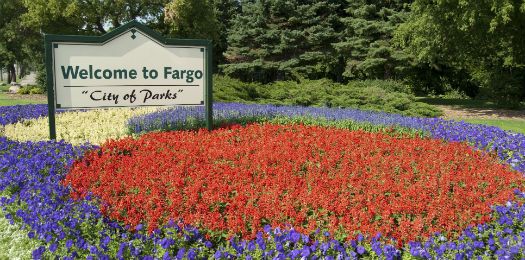
- Population: 115,863
- Percent of people 25+ with a bachelor's: 24.8%
- Unemployment rate: 2.5%
- Median annual rent: $7,260
Fargo takes the No. 1 spot on our list, due in large part to extremely low unemployment rates and short commute times: 88 percent of commuters spend 30 minutes or less on the road. Those strong lifestyle scores help attract an educated crowd, too — Fargo ranked ninth for the percentage of people over age 25 with a bachelor's degree. North Dakota State University, a research university with a total enrollment of around 15,000, is located in the heart of Fargo.
2. Aberdeen, South Dakota
- Population: 27,800
- Percent of people 25+ with a bachelor's: 19.2%
- Unemployment rate: 2.9%
- Median annual rent: $5,688
Coming in at No. 2, Aberdeen ranks extremely well on several important lifestyle factors. Low rents are coupled with low unemployment rates, and those who do work enjoy the luxury of short commute times, with 90 percent boasting a commute time of 30 minutes of less. Much of Aberdeen is within an easy distance of the campus of centrally located Northern State University, which was founded in 1901 and currently enrolls more than 3,200 students, as well as Presentation College, a Catholic private college.
3. Bloomington, Illinois
- Population: 78,730
- Percent of people 25+ with a bachelor's: 28.1%
- Unemployment rate: 5.5%
- Median annual rent: $7,332
The bronze medal of small college towns goes to Bloomington, home of Illinois Wesleyan University. Enrolling around 2,000 students, this small school packs a big punch when it comes to employment rates: 72 percent of Illinois Wesleyan graduates from the class of 2014 are employed full time within six months of finishing school, according to the school's website. This may be part of what is boosting an educated population in the town: Bloomington ranked third for the percentage of the population with bachelor's degrees. Although the median annual salaries are among the highest on the list, at $41,332, rents have stayed relatively low, counting for just below 18 percent annually of an average individual's earnings.
4. Bozeman, Montana
- Population: 41,660
- Percent of people 25+ with a bachelor's: 30.8%
- Unemployment rate: 3.5%
- Median annual rent: $8,712
Ranked second for both educational attainment (more than 30 percent of residents possess bachelor's degrees) and restaurants (there are more than 14 per 10,000 people), Bozeman offers both demographic and lifestyle perks for college students. Montana State University enrolls around 15,000 students — a large student population relative to the city's. With two ski areas nearby, miles of biking and hiking paths, and Yellowstone National Park just 90 miles away, Bozeman is a great choice for students who love outdoor recreation.
In their own words:
"Bozeman is small enough to have a personality and big enough to have all the amenities of a city. Four museums, numerous art galleries, a symphony, a ballet, an opera company and several community theaters set Bozeman apart as one of the most arts-vibrant small towns in America."
— Alison Reidmohr, Marketing Strategist at Montana State University
5. Grand Forks, North Dakota
- Population: 56,057
- Percent of people 25+ with a bachelor's: 18.5%
- Unemployment rate: 2.9%
- Median annual rent: $7,224
Grand Forks is home to the University of North Dakota, the state's oldest and largest university, which currently enrolls more than 15,000 students. Grand Forks' low unemployment rates and commute times (more than 87 percent of commuters have a commute of 30 minutes or less) are part of what puts this small city at a healthy No. 5. Boosting its overall scores might be the nightlife — there are about four bars per 10,000 residents, plus a great deal of local enthusiasm for the university's ice hockey and football teams.
6. Mankato, Minnesota
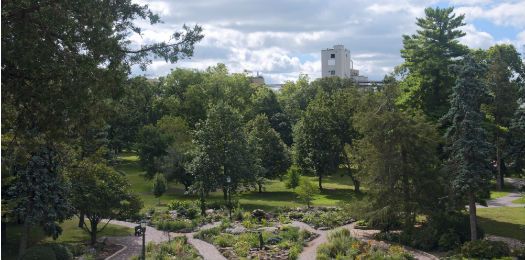
- Population: 40, 411
- Percent of people 25+ with a bachelor's: 21.8%
- Unemployment rate: 3.4%
- Median annual rent: $7,500
Mankato comes in as the sixth town on our list by virtue of its low unemployment rates and youthful population, with more than 28 percent of its adult residents being younger than 34. The majority of commuters — nearly 87 percent — enjoy travel times under 30 minutes. More than 15,000 people attend Minnesota State University-Mankato, founded in 1868 as Mankato Normal School and later known as Mankato State University. The state university isn't the only option for higher education or entertainment, however. Mankato is also home to Bethany Lutheran College and a lively, revitalized downtown.
7. La Crosse, Wisconsin
- Population: 52,440
- Percent of people 25+ with a bachelor's: 18.4%
- Unemployment rate: 4.4%
- Median annual rent: $7,212
Ranking first for bars — with nearly seven for every 10,000 people — and 25th for its WalkScore, La Crosse's nightlife and walkability places it seventh overall on our list. La Crosse is home to the University of Wisconsin-La Crosse, which enrolls more than 10,000 students, and also hosts Western Technical College and Viterbo University, a private Roman Catholic liberal arts school. La Crosse is known for the strong sense of community between its student population and the rest of the town, and the university is proud of that fact.
In their own words:
"Families host dinners for host dinners for neighboring students or bring students cookies as they welcome them to the community. In return, numerous student organizations volunteer in the community for fundraisers like Rotary lights and Neighbor's Day."
— Brad Quarberg, Director of News and Marketing at UW-La Crosse
8. Appleton, Wisconsin
- Population: 73,971
- Percent of people 25+ with a bachelor's: 19%
- Unemployment rate: 4.3%
- Median annual rent: $7,224
Appleton, Wisconsin, coming in eighth overall, has a strong local economy, with low unemployment and relatively low median rent relative to incomes. Appleton also ranked well for nightlife, boasting just over four bars per 10,000 residents, and outdoor recreation is a perk of the area as well, given town's location near the north end of Lake Winnebago. Located adjacent to Appleton proper is Lawrence University, a liberal arts college and conservatory of music that enrolls around 1,500 students.
9. Helena, Montana
- Population: 29,943
- Percent of people 25+ with a bachelor's: 23.9%
- Unemployment rate: 3.7%
- Median annual rent: $7,644
Helena, the capital of Montana and also one of the smallest towns on our list, received high marks for the level of education — nearly a quarter of the town's adult residents have bachelor's degrees. That, in combination with a relatively low unemployment rate, short average commute times, and plenty of restaurants and bars, put it in ninth place overall. Carroll College, a private Catholic liberal arts college enrolling around 1,400 students, is located in the center of Helena, as is Helena College, a comprehensive two-year school affiliated with the University of Montana.
In their own words:
"Helena is a tight-knit community who embrace the college and the students as their own. There are an abundance of social opportunities within walking distance of campus including numerous restaurants, quaint coffee and movie houses, unique stores and an array of community events."
— Sarah Lawlor, Director of Public Relations at Carroll College
10. Cedar Rapids, Iowa
- Population: 129,195
- Percent of people 25+ with a bachelor's: 20.2%
- Unemployment rate: 4.6%
- Median annual rent: $6,444
Rounding out the top 10 is Cedar Rapids, which is located in the eastern half of Iowa and is the state's second-largest city. Low median rents relative to median incomes mean that housing can cost as little as 17 percent of a resident's annual earnings. Cedar Rapids is home to both Coe College, founded in 1851, and Mount Mercy University, a liberal arts college that boasts a student-to-faculty ratio of 13 to one. Both of these institutions enroll under 2,000 students each.
11. Columbia, Missouri
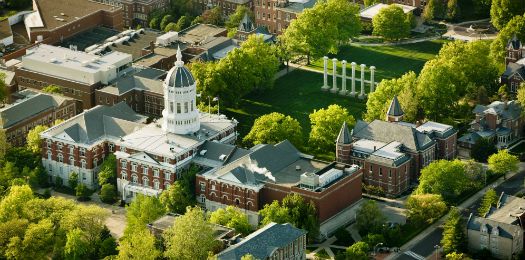
- Population: 116,906
- Percent of people 25+ with a bachelor's: 27.1%
- Unemployment rate: 4.1
- Median annual rent: $7,416
Columbia got high marks for the portion of the population aged 20-34 (more than 30 percent) and for the percentage of the population with a bachelor's degree (ranking fourth overall). Columbia hosts several festivals throughout the year, including the "Blind" Boone Ragtime and Early Jazz Festival, the True/False Film Fest, and the Boone County Fair, established in 1835. The University of Missouri, which enrolls a whopping 34,000+ students, was founded in 1839 and holds the distinction of being the first public university west of the Mississippi River. The college football team is one of the town's most popular draws and games are a citywide event, even for those outside the stadium.
In their own words:
"Mizzou Tigers game days mean everyone throughout town is dressed in black and gold. The university is a large economic driver for the city and is one of the city's largest employers."
— Jesslyn Chew, University of Missouri News Bureau
12. Dubuque, Iowa
- Population: 58,436
- Percent of people 25+ with a bachelor's: 17.6%
- Unemployment rate: 4.3%
- Median annual rent: $6,480
Dubuque ranked 11th for commute times, with almost 87 percent of commuters getting to work in 30 minutes or less, and 12th for the number of bars per 10,000 residents. Clarke University, with a total enrollment of around 1,200 students, is a Catholic liberal arts college started by a pioneering Irish woman named Mary Frances Clarke in 1843. Clarke offers 31 different majors and a student to faculty ratio of 11 to one. The city has been recognized before, too: In the past, Dubuque has been rated as one of "America's Top 100 Places" by RelocateAmerica and was ranked No. 10 on Kiplinger's list of "Great Places to Live."
13. Stillwater, Oklahoma
- Population: 48,406
- Percent of people 25+ with a bachelor's: 20.9%
- Unemployment rate: 3.7%
- Median annual rent: $6,504
The students of Oklahoma State University have called Stillwater home since the founding of the university in 1890. Today, they enjoy a young city demographic — more than a third of adult residents are younger than 34 — and low unemployment, tying for 15th overall. The community is known for being incredibly welcoming to Oklahoma State's students and for what's described as "America's Greatest Homecoming Celebration," a weeklong event that includes a carnival, parade and, of course, a football game.
In their own words:
"The community and university have an outstanding town-gown relationship. The community relies heavily on OSU students for employment, so students get plugged into the community. OSU employees are also active in the community in both service and leadership (the current mayor is an OSU faculty member). The school color of bright orange is the dominate color across Stillwater."
— Gary Shutt, Director of Communications for Oklahoma State University
14. Burlington, Vermont
- Population: 42,211
- Percent of people 25+ with a bachelor's: 25.8%
- Unemployment rate: 3.1%
- Median annual rent: $10,488
A large city by Vermont standards, as the whole state is home to only 626,562 people, Burlington has several advantages for college students, including a large demographic of educated residents, low unemployment (it ranked sixth) and plenty of dining out opportunities (nearly 10 restaurants per 10,000 residents). The University of Vermont enrolls more than 12,000 students on its campus near Lake Champlain. Founded in 1791, it is the fifth-oldest university in New England, after Harvard, Yale, Dartmouth and Brown.
15. State College, Pennsylvania
- Population: 42,100
- Percent of people 25+ with a bachelor's: 20.8%
- Unemployment rate: 4.1%
- Median annual rent: $9,540
As the name might suggest, State College is home to The Pennsylvania State University, better known as Penn State, which enrolls more than 46,000 students. It ranks sixth in our analysis for the percentage of residents aged 20-34 and ninth for walkability, based on its WalkScore of more than 65. The State College area, which includes the borough and the townships of College, Harris, Patton, and Ferguson, is commonly referred to as "Happy Valley" by its enthusiastic residents. Penn State was chartered as one of the first colleges of agricultural science in the nation in 1855. Today, it offers a wide range of graduate and undergraduate degree programs.
16. Ann Arbor, Michigan
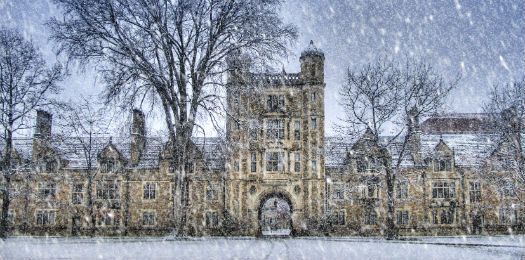
- Population: 117,770
- Percent of people 25+ with a bachelor's: 25%
- Unemployment rate: 4.8%
- Median annual rent: $9,600
If studying in a highly educated town is important, Ann Arbor may be the place for you. Not only does it rank seventh overall for educational attainment, but it's also home to the University of Michigan, Cleary University and Concordia University-Michigan. The University of Michigan boasts the largest research expenditure for any university in the country, at over $374 million, and it's consistently ranked as one of the best universities in the U.S. as well, particularly for its business and engineering programs.
17. Rochester, Minnesota
- Population: 111,402
- Percent of people 25+ with a bachelor's: 21.4%
- Unemployment rate: 3.4%
- Median annual rent: $8,004
Rochester may be most famous as the home of the Mayo Clinic, and in keeping with the town's overall reputation, its educational opportunities largely center on health care. The Mayo Medical School, Mayo School of Health Sciences and Mayo Graduate School, all of which are run by the clinic, are located in Rochester, as is the University of Minnesota-Rochester, which focuses on health science and biotechnology education. The student population is small, with a little under 1,350 students, but Rochester has a lot to offer students both during and after college, as it ranks sixteenth overall for educational attainment and eighth for unemployment.
18. Albany, New York
- Population: 98,566
- Percent of people 25+ with a bachelor's: 18.8%
- Unemployment rate: 4.9%
- Median annual rent: $8,916
The State University of New York at Albany offers its students more than 120 undergraduate majors and minors to choose from, in addition to more than 200 honor clubs and societies. The city itself ranked decently across all categories, with a restaurants rank of 22nd and a WalkScore rank of 11th. Albany's vibrancy may be due in part to its role as the capital of New York, as well as its rich history: Dating back to the early 17th century, it is one of the oldest surviving settlements of the original thirteen colonies and the longest continuously chartered city in the United States.
19. Quincy, Illinois
- Population: 40,805
- Percent of people 25+ with a bachelor's: 14%
- Unemployment rate: 5.4%
- Median annual rent: $4,992
Although its population isn't as young, on average, as most of the other cities in our analysis, Quincy made the cut by largely by virtue of its low rent prices, which gave it a rent-to-earnings rank of fourth. It also ranked 13th for bars, with more than four per 10,000 residents. Located along the Mississippi River, Quincy gives residents plenty of options for things to do, including local museums, historical architecture and access to the Mississippi Valley Wine Trail. Quincy University, founded in 1860 by Franciscan Friars, today opens its doors to students of all faiths and enrolls around 1,500 students.
20. Hastings, Nebraska
- Population: 24,915
- Percent of people 25+ with a bachelor's: 13.5%
- Unemployment rate: 3.4%
- Median annual rent: $5,784
Those living in Hastings, Nebraska, home to Hastings College, enjoy lower unemployment rates (it ranks 8th) and commute times (it ranks 14th) than they would in the majority of the other cities on our list. Hastings also offers 3.5 bars per 10,000 residents and a historic downtown. Hastings College, which enrolls about 1,100 students, offers a student-to-faculty ratio of 12 to one, plus over 60 majors in 32 areas of study. The college is woven into the history of the town, having been founded just 10 years after Hastings itself.
21. Boulder, Colorado
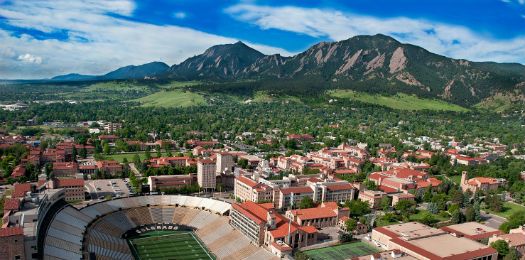
- Population: 105,112
- Percent of people 25+ with a bachelor's: 31.9
- Unemployment rate: 4.1%
- Median annual rent: $11,976
Ranking first for educational attainment, Boulder offers a highly academic environment to incoming students. Both the University of Colorado's flagship campus and Naropa University are located in Boulder, and the city is famous for its beautiful setting, including views of the iconic Flatirons and the Rocky Mountains, and its many opportunities for outdoor recreation. It also boasts many federal research labs, a strong commitment to the environment and sustainability, and more than 300 days of sunshine per year.
In their own words:
"Boulder supports a renowned entrepreneurial and tech community, and has some of the region's best restaurants. … CU-Boulder hosts CU on the Weekend during the academic year, inviting the community to be part of the campus by offering numerous free events, programs and lectures."
— Julie Poppen, Senior News Editor for the University of Colorado
22. Syracuse, New York
- Population: 144,263
- Percent of people 25+ with a bachelor's: 16.6%
- Unemployment rate: 5.6%
- Median annual rent: $7,380
Home to Syracuse University, Le Moyne College, SUNY College of Environmental Science and Forestry, and Upstate Medical University, this northeastern town offers solid scores across multiple categories, especially its ranking for WalkScore (14th) and bars (33rd). Among its other attractions, Syracuse is known for its music. The city hosts two annual outdoor jazz festivals, and the Syracuse Symphony Orchestra plays more than 200 concerts every year. Syracuse University, founded in 1870, boasts a diverse student population that currently represents all 50 U.S. states, along with 123 countries.
23. Provo, Utah
- Population: 114,801
- Percent of people 25+ with a bachelor's: 24.9%
- Unemployment rate: 3.5%
- Median annual rent: $9,012
Ranking eighth for educational attainment and 12th for both its youthful population and low unemployment, Provo is a beautiful city nestled between the Wasatch Range and Utah Lake. It's famous as the home of Brigham Young University, which enrolls more than 31,000 students and is run by The Church of Jesus Christ of Latter-day Saints. The Provo area offers spectacular opportunities for outdoor enthusiasts: It's home to both Provo Canyon and Rock Canyon, which includes the rock climbing destination Squaw Peak.
24. Erie, Pennsylvania
- Population: 99,452
- Percent of people 25+ with a bachelor's: 15.8%
- Unemployment rate: 6.1%
- Median annual rent: $6,240
Erie, located in northwestern Pennsylvania along the shores of Lake Erie, is home to several higher learning institutions, including Mercyhurst University, Gannon University, Penn State Behrend and the Lake Erie College of Osteopathic Medicine. It ranked in the top 20 for both the number of bars per 10,000 residents and for its WalkScore. Erie boasts several museums and parks, including the Erie Art Museum, the Erie Zoo, and Presque Isle State Park, and it's also known for its strong theater culture.
25. Bloomington, Indiana
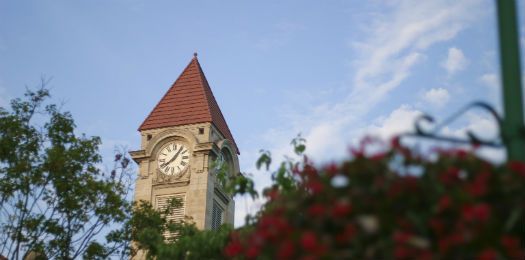
- Population: 83,322
- Percent of people 25+ with a bachelor's: 19.2%
- Unemployment rate: 5.8%
- Median annual rent: $7,968
Bloomington ranked third overall for the share of its population aged 20-34, with more than 32 percent of residents falling into that category. The city is proud of its emphasis on arts and culture, including an officially designated arts district, and of its university, which is known for both its high-quality academics and its stunning campus. Many of the buildings are constructed from Indiana limestone. Founded in 1820, Indiana University Bloomington is the flagship campus of that state's university system, and since its inclusion in Thomas Gaines' "The Campus as a Work of Art" as one of the five most beautiful campuses in America, it has continued to be a mainstay on lists of the country's loveliest colleges.
Methodology
We ranked 170 U.S. cities that have populations under 150,000 and are home to at least one 4-year college or university, based on 2014 data from the U.S. Census and the National Center for Education Statistics. Each city was ranked on a 20-point scale on the following seven factors:
- Percentage of the population aged 18-34, American Community Survey, 2013
- Percentage of the population with a bachelor's degree, American Community Survey, 2013
- Median annual rent as a percentage of median annual earnings, American Community Survey, 2013
- County unemployment rate, Bureau of Labor Statistics, 2014
- Percentage of commuters whose average travel time is less than 30 minutes, American Community Survey, 2013
- Walkability, based on WalkScore.com data supplied by Redfin, 2015
- The number of bars and restaurants per 10,000 residents, County Business Patterns, 2013
We limited the results to two cities per state, taking the two highest-ranked cities and skipping any additional ones in to create our final list of the top 25.
Sources:
1. School pages: About Hastings, http://www.cityofhastings.org/about-hastings/history.html; Bloomington, Indiana, https://en.wikipedia.org/wiki/Bloomington,_Indiana; Brad Quarberg, interview with the author via email, October 2015; Brigham Young University, http://yfacts.byu.edu/Article?id=130; Carroll College, http://www.carroll.edu/about/helena.cc; Clarke University, http://www.clarke.edu/page.aspx?id=44; Illinois Wesleyan University, https://www.iwu.edu/; Indiana University, https://www.indiana.edu/about/index.html;
Hastings College, http://www.hastings.edu/about-hastings-college; Lawrence University, http://www.lawrence.edu/admissions/about; Mercyhurst University, http://www.mercyhurst.edu/about-mu/fast-facts; Minnesota State University - Mankato, http://www.mnsu.edu/about/; Montana State University, http://www.montana.edu/about/; Mount Mercy University, https://www.mtmercy.edu/fast-facts; North Dakota State University, https://www.ndsu.edu/about/; Northern State University, http://www.northern.edu/about/Pages/ur/mediainquiries.aspx; Oklahoma State University, https://news.okstate.edu/fast-facts; The Pennsylvania State University, http://www.psu.edu/this-is-penn-state/our-history; State University of New York at Albany, http://www.albany.edu/academics/majors.shtml?WT.source=home; Syracuse University, http://www.syr.edu/about/facts.html; The University of Missouri, http://missouri.edu/about/index.php; The University of North Dakota, http://und.edu/discover/about-und.cfm; The University of Colorado, http://www.cu.edu/mission-university-colorado-guiding-principles-and-vision-statement; The University of Michigan, http://alumni.umich.edu/about/university-of-michigan-history; University of Minnesota-Rochester, https://r.umn.edu/academics-research/programs; The University of Vermont, http://www.uvm.edu/about_uvm/uvm_facts; Quincy University, http://www.quincy.edu/information/mission-and-vision.html
3. Columbia, Mo, http://www.visitcolumbiamo.com/section/festivals/
4. Erie, Pennsylvania State Parks, http://www.erie.pa.us/AboutErie/LocalAttractions.aspx
5. Provo Welcome Home, http://www.provo.org/about-us/quality-of-life
6. The Official Site of the City of Albany, NY, http://www.albanyny.org/Visitors/HistoryandEducation.aspx
7. United States Census Bureau, http://www.census.gov/popest/
8. Interview with the author via email, October 2015: Gary Shutt, Jesslyn Chew, Julie Poppen, Ken Brown, Sarah Lawlor, Brad Quarberg,
Alison Reidmohr